As an Amazon Associate I earn from qualifying purchases.
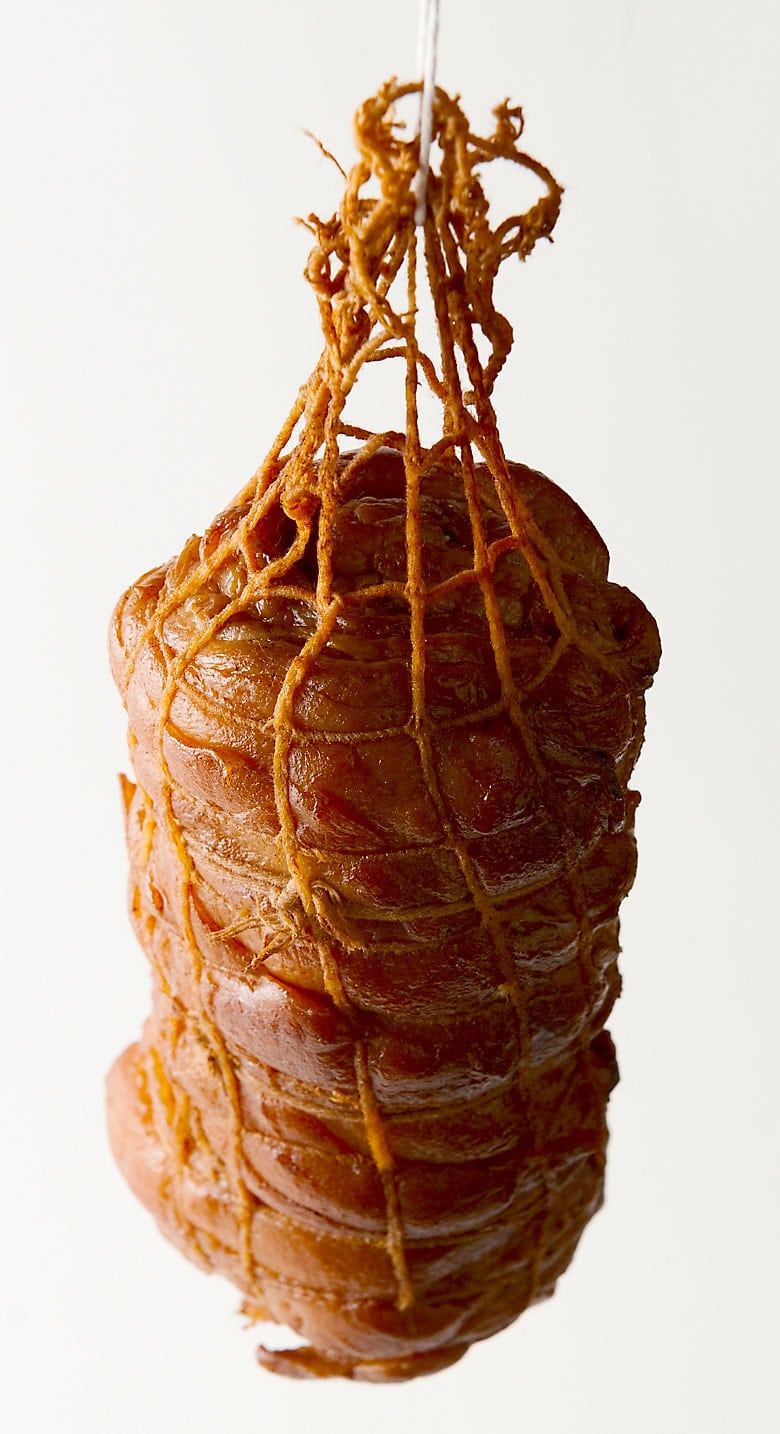
I always knew the French had their own version of bacon, but until I met Kate Hill I thought it was all unsmoked variants on petit salé. But in Gascony, Hill says they favor a lightly cured, smoked bacon called ventreche.
Ventreche (ven-tresh) tastes more like fresh pork and less like a cured meat, and is normally kept pretty simple: Pork belly, salt, black pepper and smoke.
Ventreche becomes a base for pretty much anything a cook in the Gascon countryside might make. Chopped into batons, it’s awesome in veggie dishes like succotash — I bet it’d be fantastic in a Cajun maque choux — or with short pasta, eggs of any kind, green salads, or tossed into stews like cassoulet. Or you could just crisp some up and eat it as a snack.
This is an easy bacon to make, and you don’t even need to smoke it; unsmoked versions exist in France. You start with a nice slab of pork belly.

This one is from a wild hog sow that was fat enough to make bacon. Cut the slab into a rectangle that you can later roll and tie. Next you salt the hell out of it.
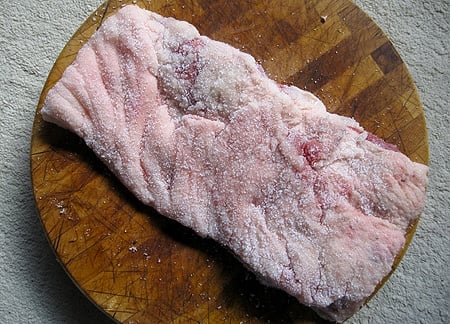
How much salt? The detailed recipe is below for amounts. Only use kosher salt or pure sea salt. Do not use iodized salt, as it contains anti-caking agents that will give your bacon a weird taste. Put the salted belly into a plastic bag. Seal it and put it in the fridge. How long? Kate only cures her ventreche for a day. I cured mine for two days. I would not go longer than 4 days, and remember: Ventreche is supposed to be lightly cured, not like our bacon.

When the belly has cured to your liking, take it out and rinse it briefly under cold water. Pat it dry and let the ventreche dry at room temperature for an hour or so. I put mine on a wire rack under a ceiling fan for air circulation. Coat the inside of the belly with black pepper. The “inside” should be the leaner of the two sides, and this will be the side you plan on rolling up.
Now it’s time to roll the ventreche. Roll it tightly into a coil starting with the narrow side of the rectangle. Slip some butcher’s twine underneath. Do this at least three times, and use as much twine as you want.
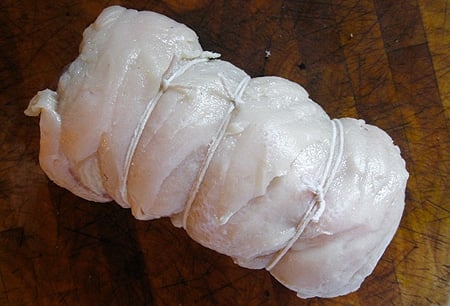
Note that if you have sausage netting, you will only need to tie the ventreche a few times. If you don’t have netting, tie it more often. Once you tie the ventreche, work the netting over it.
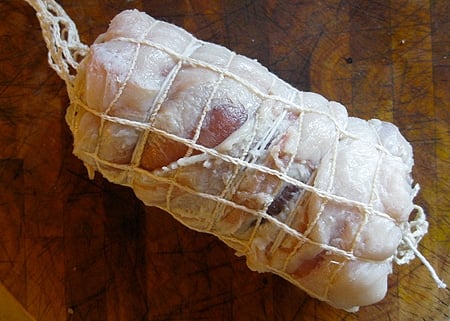
Leave a length of netting on one end so you can hang the ventreche in the smoker. Tie off the other end so the bacon does not slip out.
If you don’t have a smoker, I would hang the ventreche in the fridge for up to a week or so. This will dry it out a bit and make it a little more interesting in flavor. You don’t have to, though. If you have a smoker, get it set up. Hang the ventreche and smoke it over the wood of your choice (I use oak here), for a few hours.
Remove it when the ventreche is a pretty golden color. Once it’s finished, eat this within a week or so or freeze it.
Ventreche, French Bacon
Ingredients
- 2 pounds pork belly, in one piece
- 20 grams kosher salt, about 2 rounded tablespoons
- 1/4 cup freshly ground black pepper
Instructions
- Trim the pork belly into a neat rectangle. Salt it on both sides, massaging the salt into the meat. Put the salted belly into a plastic bag and seal it. Store in the fridge for 3 to 5 days. Flip the belly twice a day.
- Remove the cured belly and rinse quickly under cold water. Pat dry and place on a wire rack in a breezy place for an hour. Coat liberally with the black pepper and roll tightly. Tie off tightly, and then net with sausage netting.
- Hang in your smoker and smoke for 4 to 6 hours at 225°F -- you want the interior of the bacon to be at least 140°F, and 150°F is better. What wood you choose is up to you; I use oak or pecan. Use or freeze within 10 days.
Notes
Nutrition
Nutrition information is automatically calculated, so should only be used as an approximation.
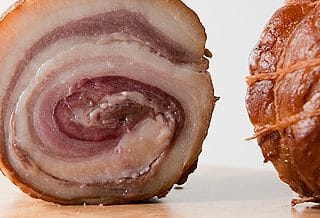
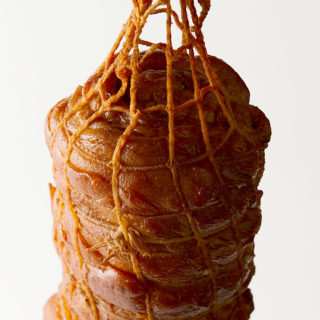

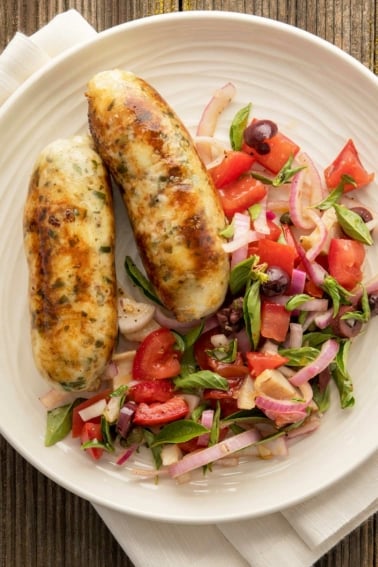
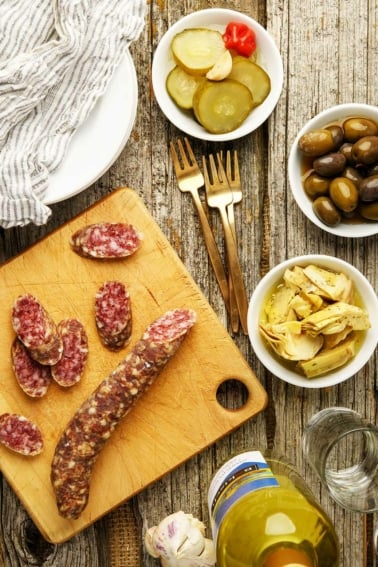

Should the skin be removed from the belly? It looks like it has been in your pictures.
Also, do you coat BOTH sides with pepper? The pics would suggest only the inside/flesh side gets pepper…
Duh … I re-read the recipe, and got my answer. Sorry!
I see that you use pork belly to make your ventreche. How do you find pork belly?
Nicole: In a butcher shop.
Hey Hank – I’m about to try this great sounding recipe w/ a piece of Tamworth belly from a pig I butchered last fall. I only have a Big Chief smoker and have only ever smoked fish. So my questions are… Will this work with the Big Chief – I think it is cooler than 250 degrees. Also, do you have any advice for how many trays of wood chips I should use during the 4-6 hours of smoking? And would Alder be ok? Thanks a bunch! I LOVE LOVE LOVE your webpage and every recipe I have made from it.
I cold smoke this way:
Smoke is generated in my Kamado smoker. Any hot smoker where intake air can be damped should work. I duct the smoke into a beer case box via an aluminum dryer duct taped (duct taped of course) into it. I put a metal free-standing grill inside the case box. I put a long probe thermometer in the case box and fold the flaps over. The longer the dryer duct, the more heat is lost between the smoker and the box. I have cold smoked salmon, tuna, sausages, belly bacon and guanciale this way. I just smoked 5 pounds of Landjäger (your recipe) and the temp in the box never exceeded 100 degrees F.
Great blog!
Does the pork belly need to be fresh (as opposed to frozen and then thawed) when you make this?
I’m a little late to the game on this, but I have to ask- would it be possible to do this with a jowl, do you think? I have 1 Ossabaw and 1 Tamworth jowl waiting for me, and one or the other will need to be ready in 3 weeks. This sounds like a really nice treatment, if it would work…
Its supposed to be rather cool but pleasant here this weekend, so we’re going to give it a go. I also sent my husband this link so he can read about your version. Perhaps we’ll make a last minute change of plans as far as the smoking goes. Thanks!
Lauryn: Nope. There is no One True Bacon. Bacon is made in as many forms are there are cultures, or subcultures. Cold smoked is one form, but you will find that if you take the temperature of many “cold smoked” chambers, it is hot enough to cook the bacon. And hot smoked bacon is just as good, IMHO. What’s more, a great many bacons are not smoked at all. Take pancetta, for example.
I could go on and on with this, but suffice to say that what you are planning to do makes an excellent bacon, but cold-smoking is *very* labor intensive in terms of monitoring temperature and smoke levels. Most cold-smoking cultures do this in late fall, early spring or even winter so they can catch a break on temperature. That’s why I don’t do it. Maybe someday…
Hank, we recently butchered an Ossabow pig and are prepping to make bacon from the belly this weekend. Our plan is to create a cold smoking device using two hot smokers – smoke in one, meat in the other, and ducting between the two.
What is your opinion on hot smoking vs cold smoking of bacon? Is it still true bacon when you have hot smoked and essentially cooked it? Bacon is typically cold smoked and then cooked immediately for use, correct? Wouldn’t your version be creating something different, yet similar to bacon?
Love the wild boar belly variation, Hank. It’s the belly that puts the ventre in ventreche. A very Gascon way of saying belly+salt+pepper+smoke= life. Every good Gascon recipe starts with some cut into lardonsseared in duckfat. Can’t wait for you to come over this fall and get a taste of Gascony.
Bpaul: I’ve never tried to preserve the whole skin, although I did on the head and feet of this wild pig so I could use the trotters and make guanciale from the jowls. You can of course scald and scrape a wild pig, but it is usually impractical in the field.
I skinned this pig and butchered it from there.
Question about butchering a wild hog. Do you attempt to preserve the skin? Or do you skin it and proceed to butcher from there?
Bp
I have a friend who went through a whole ‘class’ in charcuterie, but I don’t remember her making this version of bacon (since she had a whole pig, I think she made just about every other kind). It looks and sounds amazing. I’d definitely like the smoked version over the hanged in the refrigerator one.
Love this! We smoke a lot of our meats, and later this year we’ll have a freshly butchered pig, so I’m going to try this. Thank you so much for posting. I enjoy reading all your posts!
In the Poitou region, ventreche isn’t cured or rolled, it’s more or less used exclusively on the grill. Where I live now, in Nantes, only 200km away, they don’t even know the word!
I’m from the Gers region, in the middle of French Southwest, our ventreche is either rolled or not (originally it was not rolled), never smoked.